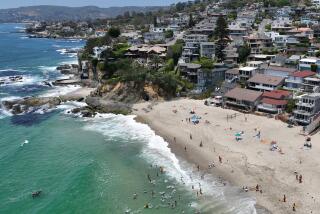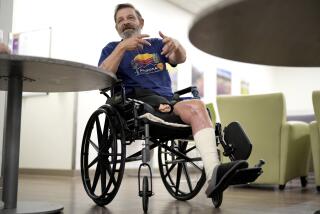Outdoor Tanning Risks : Many Beach-Goers Go UV Unconscious
- Share via
From your prone perspective on a towel spread across the sand of Santa Monica Beach, you know it’s about 70 degrees, there’s a mild breeze, the sky is virtually cloudless, the sun is blissfully hot . . . But wait! Do you know what the UV index number is today? Do you even know what the UV index is?
Bikini-clad Janice Stavile peers up from her towel, shading her eyes with her hand. “Yeah--ultraviolet index,” she nods, promptly ignoring it as she returns to suntanning.
A little way down the beach, Paul Kim, 24, hunkers down with a thick novel to spend the next two hours working on burnishing his already bronzed body. “I can assume what it is--the day’s index of ultraviolet rays indicating the dangers of skin cancer,” he says. “You’ve probably heard this a million times,” says Kim, who is of Korean descent, “but with my pigment, I just suck in the sun. I’ve never gotten sunburned.”
*
And so went the litany from unrepentant suntanners Saturday at high noon--the most dangerous time for rays. Little more than a month after the much heralded arrival of the ultraviolet index in weather forecasts, the sun-consuming public is underwhelmed . . . though not uninformed. They all know that exposure to the sun potentially causes wrinkles and skin cancer. Either they’re doing something about it--without prompting from the UV index--or their attitude is: been there, heard that, don’t care.
“We just came to the beach for peace and rest and we didn’t think about the sun rays,” says Stavile, 31, who fits the fair-skinned prototype on which the index is based. “As you can see, we’re pretty white,” she says, laughing and looking at her friend, Jon Troop, stretched out on the towel next to her. “When I have a tan, I feel healthy. That’s why I lie in the sun. If the sun doesn’t get me, something else will.”
The index these people have chosen to ignore was a painstakingly conceived project of the National Weather Service and the Environmental Protection Agency. Still in the experimental phase in 58 cities, the index interprets the ultraviolet radiation level (from 0 to 15) in terms of the number of minutes it would take a so-called average fair-skinned person to burn. (Although sometimes the index is gauged for “least sensitive” and “most sensitive” skin types.) On Saturday, a Level 8 day, a fair-skinned person would burn--actually begin to redden--in 10 minutes.
In fact, if this were a perfect sun-blocking world, people would not use the index as a recipe for baking themselves but as a warning to always wear protective lotion, sun hats, sunglasses and avoid the sun in general during the peak hours around noon.
“We’re trying to protect not just against skin burn but cancer, cataracts and immune suppression, and those latter effects are no respecter of skin color,” says Drusilla Hufford, a branch chief at the EPA who helped develop the index.
*
But it’s an uphill battle. They tried to make the index user-friendly: “We did some focus groups,” says Nina Oligino, from the Washington-based Partners for Sun Protection Awareness, a coalition of health groups, “and time and time again people said, ‘Keep it simple.’ ”
But the Saturday index was a graph of UV level versus “minutes to burn” plotted for two skin types. Stick that index in people’s faces and they look at it like it’s a math problem.
Santa Monica lifeguard Trec Shadid, 36, has a sober assessment of the beach population’s UV consciousness. “They’re not,” Shadid says bluntly. “No sunscreen, no T-shirts.”
Shadid wears both a T-shirt and sun block with an SPF (sun protection factor) of 30-45. “I don’t check the UV index,” he says, “but I’m fully aware that the UVA and UVB levels have increased with the depletion of the ozone layer over Antarctica.”
Others were somewhat dutiful--Belinda Noriega, 13, had heard a televised report Friday night forecasting a high UV level. So she packed her No. 23 sun block, but she still had the bottle tucked away while she sat on the beach. “I didn’t want my hands full of that grease,” she says of the oily lotion , as she nibbles at a take-out breakfast of eggs and sausage.
*
Some took precautions that started long before the UV index. Annie Kakoussian of Pasadena had slathered on a 30 SPF sun block, having become a believer “after I hit 30.” She’s 36. “The skin cancer--plus aging. You age faster.”
Of course, some youthful tanners (who ironically get the most sun and therefore suffer the most damage) are lost causes. “We’re too young to worry about those things,” said Fabiola Leal, 20, coating herself with Hawaiian Tropic Dark Tan Lotion No. 4. “We just come to get a tan.”
But one of the most cavalier sun worshipers was Dorothy Goff, a 71-year-old La Crescenta woman who takes a bus three times a week to the beach. Goff, a part-time waitress, smokes two packs of cigarettes a day, swims, dives and tans. “I don’t burn,” says the blue-eyed, light-haired woman. Her fair-skinned face is lined--the sign of 71 years of life as well as sun, no doubt. “I’ve heard them say, ‘Stay out of the sun.’ The more they say it, the more I go in,” Goff says. “I’ve buried two kids and one husband. I live one day at a time.”



